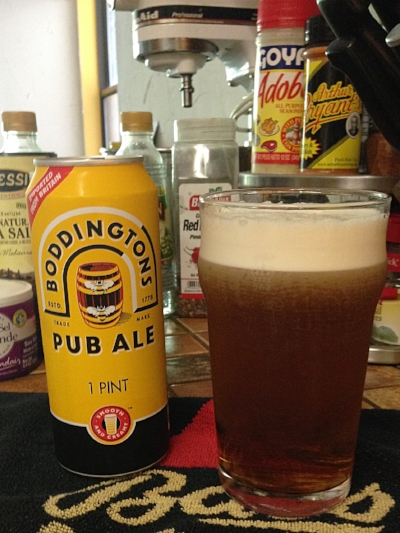Boddington Breweries, Ltd :
Boddingtons Pub Ale
Next time you are in your local pub, simply ask for a Boddies - Cheers! Sorry about the Bass Ale bar towel.
Well, yes, it's an AB InBev product, but it's still a darn good ale, although I am not all that sure of the definition of a Pub Ale. I guess, it's simply an ale - made in the UK. The pub can and the widget are a nice touch. A tasty ale - malty and sweet.
A few notes on Boddingtons' history, from the AB InBev website:
On the corner of Great Ducie Street and New Bridge Street in Strangeways, Manchester, is where two grain merchants, Thomas Caister and Thomas Fry, founded the Strangeways Brewery in 1778. Henry Boddington, who worked as a traveler (the local vernacular for repairman) joined the business in 1832 , working as a salesman and in 1848, becoming a partner. Over the years the brewery was owned by a variety of people and partnerships, but suffice it to say, Henry Boddington became the sole owner in January 1853. With Henry the sole man in charge, Henry Boddington & Company became Manchester's largest brewery, not only making a lot of beer, but also operated over 100 tied public houses.
Henry Boddington passed away in 1886, and under the new guidance of Henry's son William the company went public in 1888, and was renamed Boddingtons Breweries Ltd. What followed was years of successful brewing, with a highly loyal following, especially in the Manchester area, but also changes in corporate governance that would require a book length treatment to fully cover. The epilogue, however, is that the brewing of Boddingtons was eventually moved out of Manchester, and the now disused brewery was razed in 2007. Pity.
In 1992, Boddingtons introduced the widget can and was one of the first beers to use this technology. When Boddingtons is canned, the combination of the carbon dioxide and nitrogen needed to create the head of the beer is less than ideal. The Draught Flow System inside of the widget can consists of a plastic, nitrogen-filled ball or widget that helps the carbon dioxide already dissolved in the beer form additional tiny bubbles. This keeps the head stable and makes the beer as close to a draught brew as possible.
Anyway a good pub ale, found almost everywhere in North America - enjoy.
A vintage "Boddies" label circa 1960.
And, About the Bees: The bee, specifically the worker bee, was a symbol adopted by the city of Manchester back during the height of the Industrial Revolution. It represents the indefatigable work ethic of the Mancunians, and the hive of activity that was Manchester during that era, and indeed beyond. In 1842, the Borough of Manchester was granted an official crest, which included, among other symbols, a total of seven bees, along with the motto: Concillo et Labore (By Wisdom and Effort).
The HMS Manchester - hull number D95 - was a Type 42 destroyer in the Royal Navy. Commissioned in 1982, the ship's crest also sported seven bees, and was nicknamed the Busy Bee.
Meanwhile, back at the brewery - In 1900, Boddingtons introduced the bee symbol to its beer, clearly a nod towards the industrious folks of its hometown of Manchester. It is also said to be a play on the first letters of Boddingtons Brewery. Great stuff here.
The Royal Navy's HMS Manchester - hull number D95 - seen here in 2008 while cruising jointly with the U.S. Navy . Nicknamed the Busy Bee, she was de-commissioned in 2011. Photo: U.S. Navy
Busy Bees - a Royal Navy Ship and a fine British Ale.




